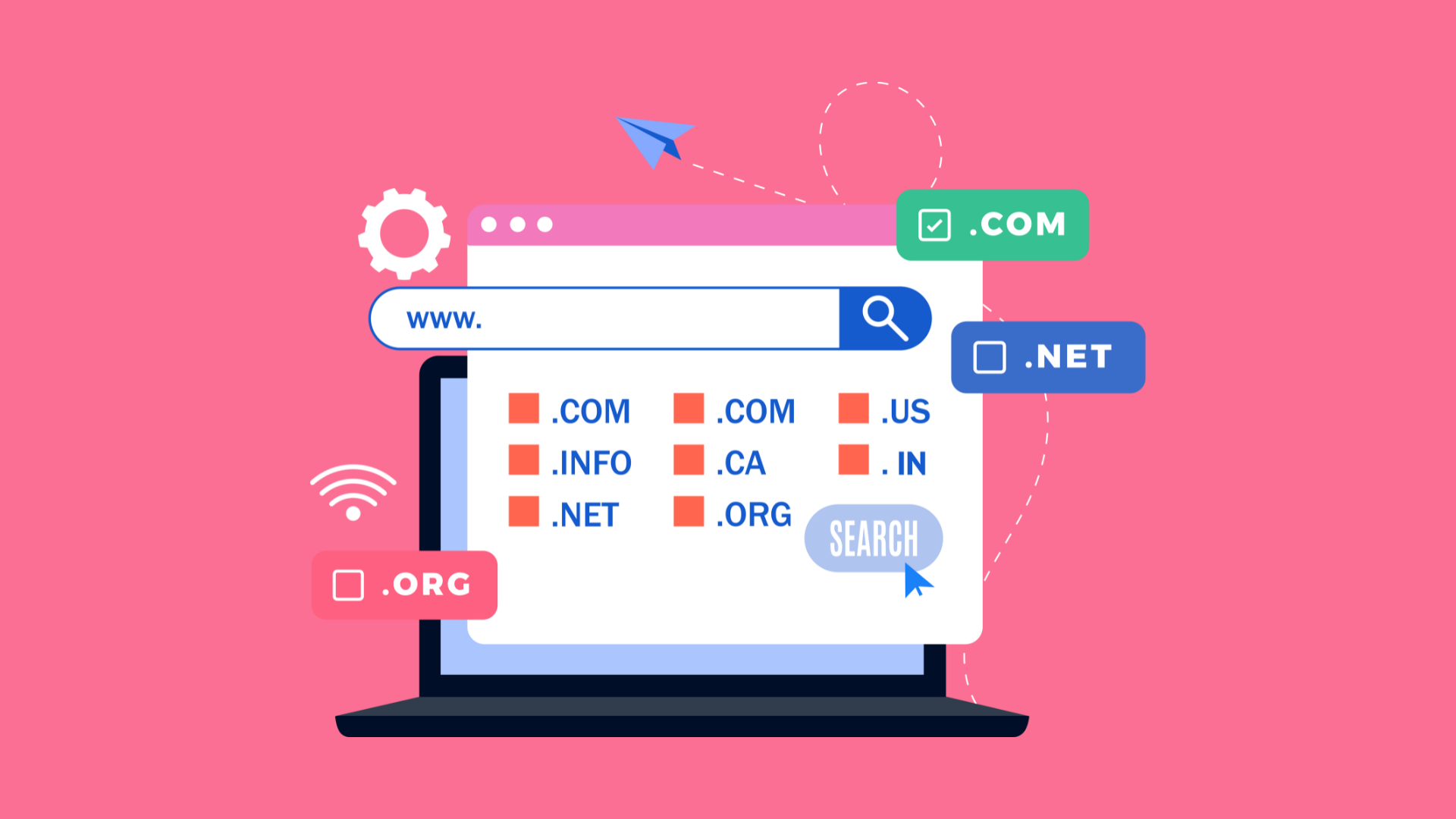Introduction
Domain names are virtual addresses that guide users to their desired online destinations. These unique identifiers play a crucial role in establishing a website's presence and accessibility, acting as the gateway through which users can navigate and interact with the content and services offered.
Whether you're seeking to establish an online presence, a business aiming to build a solid digital brand, or a website development agency looking to disseminate information, understanding the significance and mechanics of domain names is essential for success in the digital realm.
Defining Domain Name
What is web domain?
A domain name is a unique, human-readable address used to identify and locate websites on the internet. It is a user-friendly alternative to the numerical IP (Internet Protocol) addresses that computers use to communicate.
When you enter a domain name into your web browser, it acts as a pointer, directing your request to the server hosting the website's data.

Image by Canva, Canva Pro license
Domain names play a crucial role in website hosting and accessibility. Without them, users would have to remember and enter long, complex strings of numbers (IP addresses) to access websites, making the internet significantly less user-friendly and practical.
What is a Website URL?
A website URL (Uniform Resource Locator) is the address used to access a specific web page or resource online. It consists of several components that direct a user's web browser to the desired location.

Image Canva, Canva Pro license
The main components of a URL are:
- Domain Name: This unique name identifies a website, such as
example.comorwww.example.org. It serves as the website's primary address and is the URL's first part. - Path: The path follows the domain name and specifies the location of a particular page or file within the website's directory structure. For example, in the URL
https://example.com/about/team, the path is/about/team. - Parameters: Parameters, also known as query strings, are optional components that provide additional information to the web server. They are typically used to pass data or filter results. Parameters follow the path and are separated by a question mark (?), such as
https://example.com/search?query=example.
How Do Domain Names Work?
Domain names follow a lifecycle from registration to active use, with the Domain Name System (DNS) playing a crucial role in the process. When you register a domain name, it becomes associated with your website's hosting server and its corresponding IP address.
The DNS acts as a directory, translating human-readable domain names into machine-readable IP addresses. When someone types your domain name into a web browser, the following sequence occurs:
- The browser sends a request to a DNS resolver, typically provided by the user's Internet Service Provider (ISP) or a third-party DNS service.
- The DNS resolver checks its cache for the requested domain's IP address. If it does not find it, it hierarchically queries other DNS servers, starting with the root servers.
- The query travels through the DNS hierarchy, from root servers to top-level domain (TLD) servers and finally to the authoritative name servers responsible for the requested domain.
- The authoritative name servers respond with the IP address associated with the domain name.
- The DNS resolver caches and relays the IP address to the web browser.
The Role of DNS in Domain Functionality
The Domain Name System (DNS) plays a crucial role in enabling the functionality of domain names on the internet. It acts as a distributed directory that translates human-readable domain names into numerical IP addresses that computers can understand and use to locate and communicate with web servers.
When you enter a domain name into your web browser, the following process occurs:
- DNS Query: Your computer sends a DNS query to a DNS resolver, typically provided by your internet service provider (ISP) or a third-party DNS service.
- Recursive Resolution: The DNS resolver starts a recursive resolution process by forwarding the query to a root DNS server. The root server responds with the address of a top-level domain (TLD) DNS server responsible for the requested domain's TLD (e.g., .com, .org, .net).
- TLD Server Query: The resolver then queries the TLD server for the address of the authoritative DNS server responsible for the specific domain name.
- Authoritative Server Query: The resolver queries the authoritative DNS server for the IP address associated with the requested domain name.
- IP Address Resolution: The authoritative server responds with the IP address corresponding to the domain name. This IP address points to the web server hosting the website's content.
- Web Server Connection: With the IP address obtained, your computer can connect with the web server and retrieve the website's data for rendering in your browser.
Types of Domain Names
Domain names come in various forms, each serving a specific purpose and adhering to certain rules and conventions. The primary types of domain names are Top-Level Domains (TLDs), Country Code Top-Level Domains (ccTLDs), and second-level domains.
Subdomains are also a common way to organize and structure domains, allowing for further categorization and organization within a primary domain.
Top-Level Domains (TLDs)
Top-level domains (TLDs) are the highest level of the domain name hierarchy, representing the final segment of a web address. These TLDs serve as the primary identifier for the type of organization or purpose associated with a particular domain name.

Image by Canva, Canva Pro license
The most widely recognized and commonly used TLDs include:
.com: Originally intended for commercial entities, but now widely adopted by various organizations and individuals.
.org: Designated for non-profit organizations, although its usage has expanded beyond this scope.
.net: Initially intended for entities involved in networking technologies, but now utilized more broadly.
.gov: Reserved exclusively for governmental agencies and organizations within the United States.
.edu: Restricted to accredited educational institutions, primarily universities and colleges.
In recent years, the domain name landscape has expanded significantly with the introduction of numerous new generic Top-Level Domains (gTLDs). These newer TLDs cater to specific industries, interests, or geographic regions. Some examples include:
.tech: Intended for companies and individuals in the technology sector.
.shop: Designed for e-commerce businesses and online retailers.
.xyz: A versatile and memorable TLD suitable for various purposes.
.nyc: A geographic TLD representing New York City, with similar TLDs available for other cities and regions.
Country Code Top-Level Domains (ccTLDs)
Country Code Top-Level Domains (ccTLDs) are a type of top-level domain designed to represent and identify a particular country or geographic region. These domains are two-letter codes derived from international standards, such as the ISO 3166-1 alpha-2 country codes.
The primary purpose of ccTLDs is to provide a clear and recognizable online identity for websites associated with a specific nation or territory. For example, the ccTLD ".us" is designated for the United States, ".uk" for the United Kingdom, ".de" for Germany, ".fr" for France, and so on.
Using a ccTLD, website owners can immediately connect with their target audience and convey a sense of local relevance or national affiliation. This can be particularly beneficial for businesses, organizations, or individuals operating within a specific country or region, as it helps to build trust and credibility with local users.
It's important to note that while ccTLDs are primarily associated with geographic locations, they can also be used by individuals or entities without a physical presence in the corresponding country, depending on the specific registration policies.
Second-Level Domains
Second-level domains refer to the portion of a domain name that precedes the top-level domain (TLD). For example, in the domain "example.com," the second-level domain is "example." These domains play a crucial role in establishing brand and organizational identity online.
Second-level domains are the primary identifiers for websites, email addresses, and other online services associated with a particular brand or organization. They allow companies and individuals to create a unique and memorable online presence that aligns with their brand identity.
The significance of second-level domains lies in their ability to convey the nature, purpose, or focus of a website or organization. For instance, a company like Apple may use "apple.com" as its second-level domain, instantly conveying its brand identity to visitors. Similarly, educational institutions often use second-level domains that reflect their names, such as "harvard.edu" or "mit.edu."
Furthermore, second-level domains offer flexibility in terms of organization and categorization. Companies can create separate second-level domains for different products, services, or divisions, allowing for better organization and targeted marketing efforts.
Subdomains
Subdomains are additional sections or prefixes added before the primary domain name, separated by a period. For example, in the URL "blog.example.com," "blog" is the subdomain, and "example.com" is the primary domain.
Subdomains are commonly used to organize and categorize different sections or functionalities within a website. They allow web admins to create distinct areas or microsites under the same primary domain, each serving a specific purpose or target audience.
Some everyday use cases for subdomains include:
- Content organization: Subdomains can be used to separate different types of content or services a website offers. For example, a company might have "blog.example.com" for their blog, "shop.example.com" for their online store, and "support.example.com" for their customer support portal.
- Localization: Subdomains can create localized website versions for different regions or languages. For instance, "en.example.com" could be the English version, while "fr.example.com" could be the French version of the same website.
- Testing and staging: Subdomains often test and stage environments during website development or redesign. For example, "staging.example.com" could be used to test changes before deploying them to the live site.
- Third-party services integration: Subdomains can integrate third-party services or applications within a website. For instance, "analytics.example.com" could be used for hosting analytics tools, or "cdn.example.com" could be used for a content delivery network (CDN) service.
- User accounts: In some cases, subdomains are used to create personalized spaces or accounts for individual users, such as "username.example.com" for user profiles or personal blogs.
Choosing the Right Domain Name
The right domain name is crucial for establishing a solid online presence and brand identity. A well-chosen domain can be a powerful asset, reflecting your brand's values, enhancing memorability, and contributing to search engine optimization (SEO) efforts.
Here are some strategies to consider when choosing a domain name:
Align with Your Brand Identity: Your domain name should accurately represent your brand, products, or services. Consider incorporating your business name, industry keywords, or a descriptive term that resonates with your target audience. This approach helps reinforce brand recognition and makes it easier for potential customers to find you online.
Keep It Short and Simple: Shorter domain names are generally easier to remember, type, and share. Aim for a concise domain that still conveys the essence of your brand. Avoid unnecessarily long or complicated domain names, as they can be prone to misspellings and may be challenging for users to recall.
Consider Brandability: While keywords can be valuable, a unique and brandable domain name can also be advantageous. A brandable domain can help establish a distinct identity and create a memorable association with your brand, even if it doesn't directly describe your products or services.
Avoid Hyphens and Numbers: Domain names with hyphens or numbers can be more challenging to remember and prone to typos or confusion. Opt for a domain name with a single, easy-to-spell word or phrase whenever possible.
Check for Availability Across Platforms: Before finalizing your domain name choice, ensure it is available for website registration across various social media platforms and other online channels. Consistency across platforms can reinforce your brand identity and make it easier for customers to find you.
Consider Future Growth: While your domain name should accurately reflect your current business, it's also important to consider potential future growth or expansion. Choose a domain name that is versatile enough to accommodate changes or additions to your product or service offerings.
Remember, your domain name is often the first impression potential customers will have of your brand, so it's essential to choose wisely. A well-selected domain can contribute to a robust online presence, enhance brand recognition, and drive more website traffic and engagement.
SEO Best Practices for Domains
Selecting an SEO-friendly domain name is crucial for improving your website's visibility and search engine rankings. Here are some best practices to consider:
Keyword Integration: Incorporate relevant keywords into your domain name. This can help search engines better understand your website's content and purpose. However, avoid stuffing too many keywords, which can appear spammy and harm the user experience.
Length and Readability: Aim for a domain name that is short, easy to spell, and memorable. Shorter domains are generally more user-friendly and more accessible to remember and share.
Domain History: When purchasing a previously owned domain, research its history to ensure it is not associated with spam, malware, or other malicious activities. A tainted domain history can negatively impact your website's reputation and search engine rankings.
Exact Match Domains: While exact match domains (domains that precisely match a targeted keyword) can provide some SEO benefits, they are less powerful than they once were. Search engines prioritize quality content and overall user experience over exact keyword matching in domains.
TLD Selection: While the top-level domain (TLD) extension does not directly impact search rankings, some extensions like .com, .org, and .net are more widely recognized and trusted by users. If possible, choose a domain with a reputable TLD.
Registering a Domain Name
Registering a domain name is a straightforward process that involves selecting a domain registrar and following a few simple steps:
- Choose a Domain Registrar: Domain registrars are companies accredited by the Internet Corporation for Assigned Names and Numbers (ICANN) to sell domain names. Popular options include GoDaddy, Namecheap, Google Domains, and Domain.com. Research and compare pricing, features, and customer support before choosing.
- Check Domain Availability: Once you've selected a registrar, use their domain search tool to check if your desired domain name is available. If it's taken, you must explore alternative options or consider purchasing the domain from its owner.
- Complete the Registration Process: If the domain is available, proceed with the registration process. You must provide personal or business information, such as your name, address, email, and payment details. Review the terms of service and any additional policies carefully.
- Configure Domain Settings: After completing the registration, you may have the option to configure various domain settings, such as privacy protection (which masks your personal information from public WHOIS records), auto-renewal, and domain locking (to prevent unauthorized transfers).
- Connect to Your Website: Once the domain is registered, you must point it to your website's hosting server. This typically involves updating the domain's DNS settings with your hosting provider's nameservers. Consult your hosting provider's documentation for specific instructions.
Conclusion
Selecting and registering a suitable domain name is critical in establishing an effective online presence. A well-chosen domain can enhance brand recognition, improve search engine visibility, and create a lasting impression on potential customers or visitors.
The domain name serves as the digital address for your website, making it the first touchpoint for many users. A memorable, concise, and relevant domain can significantly boost brand recall and make it easier for people to find and remember your online destination.
Furthermore, a carefully chosen domain can improve search engine optimization (SEO) by incorporating relevant keywords and improving your website's ranking in search results. Increased visibility can drive more organic traffic to your site, potentially increasing conversions and revenue.
A well-thought-out domain name can provide a significant advantage. Businesses and individuals can establish a solid online identity and position themselves for success by investing time and effort into choosing and registering the correct domain.
Sep 27, 2024
